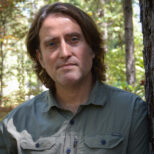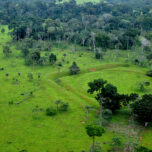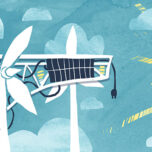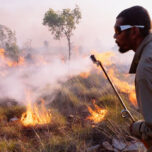January 5, 2021 — Editor’s note: The following is an excerpt from Finding Our Niche: Toward a Restorative Human Ecology, published by Fernwood Publishing, a book that is an outgrowth of essays the author previously published at Ensia.
Author’s note: Throughout this book I will use the proper name “Turtle Island” to refer to North America. Turtle Island is the name given to this continent by several Indigenous societies. I do this to represent the fact that my stories are settler stories, stories that unfold on stolen land. Using the continent’s proper given name helps to shift our understanding, from seeing it as a place that was discovered to one that was invaded.
Pat Smith first took me out into the Minto Flats on his long, white, fiberglass skiff in August of 2006. We took maybe 10 such trips in the handful of years that I knew him before cancer took him off the land, and, ultimately, sent him back to it. We fished some, but to little avail. The legion of pike that dominate the flats’ aquatic ecosystem sluggishly hugged the bottom in the unseasonably warm water, not at all interested in our flashy spoon lures. So we pretended to shoot a couple of ducks, as they were still out of season — the white man’s season, that is, a bureaucratic calendar set by people who pay little mind to the habits of the birds, condition of the land or needs of the community. Pat said it was a fine time to hunt, but he was also a rule follower by nature so the only ammo we had in the boat was for bear protection. We then drove the boat around for the good portion of the afternoon, Pat telling me the names of this hill and that oxbow, talking about the good places for getting berries, beaver, moose, and pointing to places where kids had gotten themselves lost in bad weather.
It was my first time seeing such country, a striking tangle of black and green trees, brown, mossy banks, and smooth, opalescent water. Visually, I suppose the landscape isn’t too different from the open water bogs and fens of my childhood home in southern Maine. But nonetheless, at 29, the Flats were a world apart for me. I was still new to Alaska and still recovering from an unhappy decade living in the urban sprawl of Miami. It was so quiet — but simultaneously loud with wind, with bugs, with birds. The land was so loud I could barely hear the Johnson outboard puttering along behind us if I listened right.
That first day on the Flats, my mind was awash with their expansiveness, the endless turns and sloughs that make it easy for even experienced boaters to lose track of direction if the sun isn’t there to guide you. To the south, the Flats are bounded by the Tanana River, a major tributary to the great Yukon River (Turtle Island’s third longest river). We couldn’t see it that day, but the rudder felt its pull. Later, standing atop a hill just north of Montana Creek, we could easily see the peaks of Denali and her sisters, Deborah, Hess and Hayes, to the south. Our conversation was a paradox, with talk of tradition and natural history, but also of the shifting seasons and rapid environmental changes that Pat had seen in the last few years. Pat made a small fire to brew camp tea — Lipton tea, heavy on the sugar — and we ate salmon strips and Pilot Bread crackers while talking about the pike that we didn’t catch.
A newcomer would take one look at the Minto Flats and call it “untouched,” but they’d be wrong. The people of the lakes have been living on these lands, interacting sustainably with them, for millennia.
“We should use some of your big university bucks and hold a fishing derby, like in that Rock Hudson movie,” Pat mused. Pat regularly made references to old films, often obscure ones. “Have the kids pull up as many pike as they can and then test them all for contaminants.” Pike is a fish known for building up contaminants from the environment, mercury in particular. A piscivorous fish, pike is essentially atop what is now a mercury-laced food chain (save humans), thanks to the pollution from coal-fired power plants further south. But pike remains an important fish for the Menhti kokht’ana, the “people of the lakes,” and many still eat it. The mercury is a risk that they take; some because pike is cheap and readily available, but many because not eating their traditional foods is a price too high to pay. It would hurt their souls too deeply.
Pat was being tongue in cheek, at least partially. As chief, he had seen many researchers come and go with research questions that never really lined up with the needs of his people. He knew I was trying to do something different. Something that mattered to locals. I did write a grant to fund a pike derby, but the agency turned it down, noting that they “do not generally fund monitoring, but prefer novel science that will advance the conservation of Alaska’s wild and pristine spaces.” Whether these pristine spaces remain safe for the area’s Indigenous peoples was apparently irrelevant, or perhaps, not “novel” enough.
Untouched
“Alaska’s wild and pristine spaces.” In hindsight, I’m not convinced that the person writing that email even knew what he meant with these words. They are token words, vacuous words, words regurgitated in lieu of making a real statement of purpose or value. But they are also powerful words, colonial words, words that define spaces as being meant for some people but not others. They structure how we think about humanity’s place in the natural world, where we are supposed to be, how we are supposed to act, and what we are supposed to protect. The built-in dictionary in the version of Microsoft Word that I’m using to write this offers untouched, immaculate and unspoiled as synonyms for pristine. Each implies a lack of human influence: humans touch, humans penetrate, humans spoil. Pristine spaces are spaces for animals, spaces that people must protect, and if we’re careful, that we might observe in all their majesty. They are certainly not spaces that people do, or should, inhabit.
A newcomer would take one look at the Minto Flats and call it “untouched,” but they’d be wrong. The people of the lakes have been living on these lands, interacting sustainably with them, for millennia. Before contact (with European explorers) there were easily many tens of thousands of people whose lives passed in and out of this northern oasis over the years. Some of the most influential Athabascan leaders in recorded history hail from the Flats: Traditional Chief Peter John, a major advocate for tribal sovereignty during the latter half of the 20th century, and incidentally Pat’s grandfather, was from Minto. As was Evelyn Alexander, known widely as “Sitsu,” possibly the most well-known woman in Alaska’s history.
The thing is, wherever in the world you go looking for “wild and pristine spaces,” whether the Minto Flats or the Amazon rainforest, you encounter evidence of humanity. Take the ancient temperate rainforests of the Pacific Northwest; these old growth forests are home to a multitude of different plants and animals, and also were home to some of the most populous pre-Columbian human settlements on Turtle Island. Millions of Indigenous people lived here before contact, and archaeologists have shown that the parts of the Pacific Northwest that had the most productive forests are the same places that had the densest human settlements. This is not just because people sought out the richest ecosystems — but because people were actively using fire and other techniques to manage forests and cultivate biodiversity. While there’s much we still don’t know about these ancient cultural-ecological interactions, we can say with certainty that people helped make these places more vibrant, more abundant, more pristine.
My tour of the Minto Flats with Pat was an eye opener because it completely dismantled the notion of “pristine” that I grew up with: a place that is untouched, unruly, even dangerous. The Flats look pristine in the western sense. They feel pristine, sound pristine. Yet, calling the Flats pristine erases Indigenous presence. People have lived there for millennia, and by calling it, and other places like it, “untouched,” we are evoking the concept of terra nullius, land that belongs to nobody. European colonists proclaimed Turtle Island to be terra nullius as a way to justify dispossessing Indigenous peoples of their territories (and raping and killing Indigenous women) — if something has never been used, never been under sovereign control, never been “civilized,” it is free for the taking.
Unfortunately, the colonial narrative of pre-invasion Turtle Island as a terra nullius persists, and mainstream conservation is still largely hitched to notions of wild and pristine that don’t include human beings. Governments around the world, in the name of conservation, continue to displace large numbers of Indigenous peoples from their traditional territories in the name of a more “enlightened” vision for the land. As recently as 2019, the government of India was planning to relocate millions of Indigenous people from their forest homelands. This despite the fact that research repeatedly shows that Indigenous people have long been effective stewards and guardians of their territories. Indigenous peoples’ rights in these places are also regularly challenged or ignored — violent conflict started by commercial lobster fishers against the Mi’kmaq people in Nova Scotia under the shroud of conservation concerns is only just one recent example. It’s cases like these that frequently make me question whether the 20th-century paradigm for environmentalism can ever escape its white supremacy.
Rather than defining a pristine place by what it purportedly lacks (human presence), we should instead focus on the things that pristine places have. When I think of my experiences in Alaska, I think first of abundance. I think of a time when Pat, his wife, Carla (who later went on to be chief of Minto herself), and I went back out into the flats the next summer to fish for pike. It was cooler, and the pike were everywhere in the water around us. You could see dozens of the long, shimmering creatures circling frenetically, just under the surface. They would jump out of the water to catch our silver fishing spoons as soon as the tips of our poles went over the side of the boat. One pike, maybe 2 feet in length, jumped right into the boat, and caused quite the laughter among the three of us as we tried to stop it from thrashing about frenetically at our feet.
We can, if we wish it, coexist, humans and nonhumans, without spoiling everything important and essential about these wild and pristine spaces.
At one point on this trip, Pat lost his handmade jaw-spreader over the side of the boat. Pike have strong jaws and very sharp teeth, so getting the fishing spoon and line out of their mouths can be a bloody experience without a tool to hold their mouths open. I knew it had sentimental meaning to him, a gift from an old friend, so I jumped over the side. The water was only about belly deep, and in my eagerness to get the spreader back for him I forgot about the hundreds of hungry pike swimming around under the surface. Now, pike won’t generally try to bite something that doesn’t look like a fish, so I wasn’t in any real danger. Still, the feeling of being so outnumbered, and by so many mouths full of sharp teeth, was surreal. Even when I was moving around, searching with my hands and feet for the lost spreader, they saw me as no threat.
I found the spreader, still in the jaws of an unlucky pike. Pat said he was glad that the pike didn’t die down there, losing its life for nothing. We boated back that day with about two dozen fish, not for ourselves but for a potlatch, a large ceremony often held to commemorate a birth or death. A ceremony where the fish would be thanked for their gift.
It would be banal to compare this intimidating swarm of pike to the settler accounts of diversity from times past: flocks of passenger pigeons so dense they blocked out the sun, or of Pacific salmon runs so thick you could walk across the inlet. These are tales that fetishize untouched nature, that we tell to inspire guilt, not awe. These tales serve a purpose, I suppose, to remind us of how much damage we can do when we’re careless. But they don’t help us understand why we should care, why that abundance matters.
Instead, what I learned from my encounter with pike that day, as they swirled around me as if I were a tree stump, paying no mind, was that there was enough space for all of us despite their impressive abundance. We weren’t mutually exclusive. We can, if we wish it, coexist, humans and nonhumans, without spoiling everything important and essential about these wild and pristine spaces.
Editor’s note: The views expressed here are those of the author and not necessarily of Ensia. We present them to further discussion around important topics. We encourage you to respond with a comment below, following our commenting guidelines, which can be found on this page. In addition, you might consider submitting a Voices piece of your own. See Ensia’s Contact page for submission guidelines.
Editor’s note, 1/8/21: The location of the conflict between commercial lobster and the Mi’kmaq people was corrected.
Related Posts
Ensia shares solutions-focused stories free of charge through our online magazine and partner media. That means audiences around the world have ready access to stories that can — and do — help them shape a better future. If you value our work, please show your support today.
Yes, I'll support Ensia!




